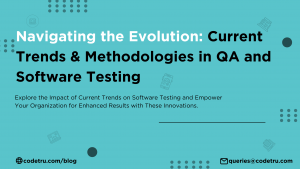Quality assurance (QA) is a vital aspect of software development that ensures the quality and functionality of software products and services. QA testing involves testing software throughout the development lifecycle, from planning to deployment, to identify and fix defects, bugs, and errors.
As the software industry evolves rapidly, so do the QA practices and tools. In 2024, QA professionals will face new challenges and opportunities as they adopt new technologies, methodologies, and frameworks to deliver high-quality software faster and more efficiently.
In this blog, we will explore some of the major QA and Software testing trends that are shaping the landscape in 2024, and how they can help QA teams improve their productivity, performance, and customer satisfaction.
Key Trends in Software Testing and QA
Shift Left Testing
Shift left testing is a QA approach that involves testing software earlier and more frequently in the development process, rather than waiting until the end of the cycle. The goal of shift left testing is to catch and fix defects as early as possible, reducing the cost, time, and effort of fixing them later.
This approach is one of the latest trends in quality assurance, reflecting a shift towards more proactive testing practices. Shift-left testing is enabled by adopting agile and DevOps methodologies, emphasizing collaboration, communication, and continuous delivery. By integrating testing into every stage of the development pipeline, QA teams can provide continuous feedback, validation, and improvement to the developers, ensuring the quality and alignment of the software with the business requirements.
Benefits of Shift Left Testing
Improved quality and reduced risk: By testing software in the early stages, QA teams can detect and prevent defects before they become critical or affect the end-users. This improves the quality and security of the software and reduces the risk of failures, errors, and rework.
Faster time to market: By testing software in parallel with development, QA teams can accelerate the delivery and deployment of software, and reduce the time to market. This enables the software teams to respond faster to changing customer needs and expectations and gain a competitive edge in the market.
Reduced cost and effort: By testing software early and often, QA teams can reduce the cost and effort of testing, as well as the cost and effort of fixing defects later. This optimizes the use of resources and increases the return on investment (ROI) of the software projects.
Techniques that Support Shift Left Testing
Test automation: Test automation is the use of software tools to execute tests automatically, without human intervention. It enables QA teams to run tests faster, more frequently, and more reliably, and to cover more test scenarios and cases. It also supports continuous testing, which is the practice of testing software continuously throughout the development lifecycle, and providing feedback to the developers in real-time.
Test-driven development (TDD): TDD is a software development technique that involves writing tests before writing code, and then writing code that passes the tests. TDD helps developers to design and implement software that meets the specifications and requirements, and to ensure the quality and functionality of the code. TDD also helps developers to refactor and optimize the code, and to avoid introducing new defects or errors.
Behavior-driven development (BDD): BDD is a software development technique that involves writing tests in a natural language that describes the expected behavior and outcome of the software, rather than the technical details. BDD helps developers and testers to collaborate and communicate more effectively, and to align the software with the business and user needs. It also helps testers to write tests that are more readable, understandable, and maintainable.
Scriptless Automation
Scriptless automation is another software testing trend that you should keep an eye out for in 2024.
It is a type of test automation that does not require coding or scripting knowledge to create and execute automated tests. It uses user-friendly tools and interfaces that allow testers to create tests by interacting with the software, rather than writing code.
Scriptless automation is especially useful for testers who are not familiar with coding or scripting languages, or who do not have the time or resources to learn them. It helps testers to focus on the business logic and functionality of the software, rather than the technical details and complexities of the test automation code. This approach is quickly gaining traction as part of the latest trends in quality assurance, making automated testing more accessible and efficient for a wider range of QA professionals.
Benefits of Scriptless Automation
Increased productivity and efficiency: By using scriptless automation, testers can create and execute automated tests faster and easier, and with less effort and errors. It also provides features such as test recording, playback, editing, debugging, and reporting, that simplify and streamline the test automation process.
Improved test coverage and quality: Using scriptless automation, testers can create and execute more tests, and cover more test scenarios, than with scripted or manual testing. It also provides features such as data-driven testing, parameterization, and validation, that enhance the test coverage and quality.
Reduced maintenance and dependency: By using scriptless automation, testers can reduce the maintenance and dependency of the test automation code, as they can now handle the changes and updates in the software automatically, or with minimal intervention. It also reduces the dependency on developers or programmers, as testers can create and execute automated tests independently, without relying on their code or support.
Tools and Frameworks that Support Scriptless Automation
ACCELQ
ACCELQ is a cloud-based test automation platform that enables testers to create and execute automated tests for web and mobile applications, without coding. ACCELQ uses natural language processing and artificial intelligence to generate test scripts from test scenarios and to predict test data and outcomes. It also provides features such as test design, execution, management, and reporting that support the entire test automation lifecycle.
TestComplete
TestComplete is a scriptless test automation tool that enables testers to create and execute automated tests for desktop, web, and mobile applications, without coding. It uses a graphical user interface and a keyword-driven approach to create tests by recording and playing back user actions, or by selecting predefined test commands. TestComplete also provides features such as test data generation, object recognition, cross-browser testing, and test reporting, that support the test automation process.
Avo Assure
Avo Assure is a scriptless test automation tool that enables testers to create and execute automated tests for web, mobile, and desktop applications, without coding. Avo Assure uses a spreadsheet-like interface and a data-driven approach to create tests by entering test data and parameters, or by importing them from external sources. It also provides features such as test execution, management, and reporting, that support the test automation process.
Hyperautomation and Codeless Automation
Another software testing trend gaining popularity in 2024 is Hyperautomation.
Hyper automation is the concept of automating everything in an organization that can be automated, using a combination of advanced technologies, such as artificial intelligence, machine learning, robotic process automation, and codeless or low-code development tools. It aims to streamline and optimize the processes and workflows across the organization and to enable the automation of complex and intelligent tasks that require human-like capabilities.
Codeless or low-code automation is a type of automation that does not require coding or scripting knowledge to create and execute automated tasks. It uses user-friendly tools and interfaces that allow users to create tasks by dragging and dropping predefined components, or by using natural language commands.
Hyperautomation and codeless automation are closely related, as codeless automation is one of the key enablers of hyperautomation. By using codeless or low-code automation tools, users can create and execute automated tasks faster and easier, and with less effort and errors, than with traditional coding or scripting tools. These tools also help users to automate tasks that involve multiple applications, systems, and data sources, and that require complex logic and decision-making, contributing to the latest trends in quality assurance.
Tools That Support Hyper automation and Codeless or Low-code Automation
IBM Cloud Pak for Automation
A cloud-based platform that enables users to automate tasks and processes across the organization, using a combination of artificial intelligence, machine learning, robotic process automation, and low-code development tools. It helps users to design, build, run, monitor, and manage automated tasks and processes, and to integrate them with various applications, systems, and data sources while also providing features such as data capture, content management, workflow orchestration, decision automation, and analytics, that support the hyper-automation process.
Informatica Intelligent Cloud Services
Informatica Intelligent Cloud Services is a cloud-based platform that enables users to automate tasks and processes across the organization, using a combination of artificial intelligence, machine learning, robotic process automation, and codeless development tools.
API Test Automation
It involves the practice of testing the application programming interfaces (APIs) and services that enable the communication and integration of different applications, systems, and data sources. It ensures the functionality, performance, security, and reliability of the APIs and services, and verifies that they meet the specifications and expectations.
It is becoming more important and challenging, as the software industry moves towards a microservices architecture, which involves breaking down the software into smaller, independent, and loosely coupled services that communicate via APIs. Microservices architecture enables faster, easier, and more scalable development and deployment of software, but also increases the complexity and dependency of the APIs and services.
Benefits of API and Services Test Automation
Improved Functionality and Performance
Testers can now measure and optimize the performance of the APIs and services, such as the response time, throughput, and latency, and ensure that they meet the service level agreements (SLAs).
Enhanced Security and Reliability
By testing the APIs, you can identify and prevent potential security threats and vulnerabilities, such as unauthorized access, data breaches, and injection attacks. You can also ensure the reliability and availability of the APIs and services, and that they handle the errors and exceptions gracefully.
Increased Integration and Compatibility
Testers can also ensure the integration and compatibility of the different applications, systems, and data sources that interact with them. They can validate the interoperability and compliance of the APIs and services with the industry standards and protocols, such as REST, SOAP, GraphQL, and gRPC.
Tools and Frameworks That Support Api and Services Test Automation
Postman
Postman is a popular and powerful tool for API and services test automation, that enables testers to create, execute, and manage automated tests for RESTful and SOAP APIs and services. It provides features such as test creation, execution, management, and reporting, that support the entire API and services test automation lifecycle.
Rest-Assured
Rest-Assured is a simple and elegant framework for API and services test automation, that enables testers to create, execute, and manage automated tests for RESTful APIs and services, using Java code. It provides features such as data-driven testing, parameterization, validation, and mocking, that enhance the test coverage and quality.
Cloud-based Mobile Device Labs
Cloud-based mobile device labs are platforms that provide access to real mobile devices, such as smartphones and tablets, that are hosted on the cloud, for testing purposes. These enable testers to test mobile applications and websites on various devices, operating systems, browsers, and network conditions, without having to own, manage, or maintain the devices physically.
They are essential for mobile testing, as the mobile market is highly fragmented and diverse, and mobile users are demanding and dynamic. By using cloud-based mobile device labs, testers can ensure the compatibility, functionality, performance, usability, and security of the mobile applications and websites, across different devices, platforms, and scenarios.
Platforms That Provide Cloud-based Mobile Device Labs
Browser Stack
It provides access to over 2,000 real devices, covering various operating systems, browsers, and network conditions, for testing mobile applications and websites. Browser Stack provides features such as test automation, test management, test reporting, test coverage, and test analytics, that support the entire test automation lifecycle. It also provides features such as live testing, screenshots, video recording, and debugging, that support the test quality and troubleshooting.
Sauce Labs
Sauce Labs is a comprehensive and reliable platform for cloud-based mobile device labs, that provides access to over 1,500 real devices, covering various operating systems, browsers, and network conditions, for testing mobile applications and websites. It provides features such as live testing, screenshots, video recording, and debugging, that support the test quality and troubleshooting.
Conclusion
Quality assurance is a dynamic and exciting field, that requires testers to adopt new technologies, methodologies, and frameworks, to deliver high-quality software faster and more efficiently. By following the latest trends in quality assurance and best practices, testers can improve their skills, knowledge, and performance, and contribute to the success and satisfaction of the software testing teams and customers.
FAQs About Quality Assurance & Software Testing in 2024
1. What is shift left testing and why is it important in 2024?
Shift Left Testing is a QA approach that involves performing testing activities early in the software development life cycle. This approach helps identify defects early, reducing the cost and effort of troubleshooting later on. By integrating testing at every stage of development from design to deployment, Shift Left Testing improves software quality, accelerates time to market, and reduces overall testing costs
2. How does scriptless automation benefit QA teams?
Scriptless Automation is a trend in software testing where automated tests are created without the need for coding skills. This approach provides user-friendly interfaces that allow testers to design and execute tests using intuitive tools. Benefits include increased productivity, reduced maintenance, and full compensation testing. It also empowers non-technical testers to participate in automated testing, thus expanding the scope and functionality of the testing process.
3. What role does API test automation play in modern software development?
API test automation focuses on testing application programming interfaces to ensure function correctly, perform well, and meet security standards. As software development increasingly embraces microservice design, API testing becomes essential to ensure that services communicate seamlessly. Effective API test automation improves productivity, performance, and security, making it an integral part of modern software development practices.
4. How are hyper automation and codeless automation shaping the future of QA?
Hyper automation and codeless automation are changing the QA landscape by leveraging advanced technologies such as AI and machine learning to automate complex tasks and processes. Hyper automation aims to automate everything that can be done, while codeless automation makes it easier to create test scripts using easy-to-use tools. These features increase productivity, reduce errors, and enable advanced and intelligent solutions.
5. What Are the Advantages of Using Cloud-Based Mobile Device Labs?
Cloud-based mobile device labs provide access to actual mobile devices plugged into the cloud for testing mobile applications and websites. This design allows testers to analyze their performance across different devices, operating systems, and network environments, without having to physically manage these devices. Key benefits include ensuring manufacturing consistency, improving billing testing, and reducing the cost of physical tool room maintenance.







